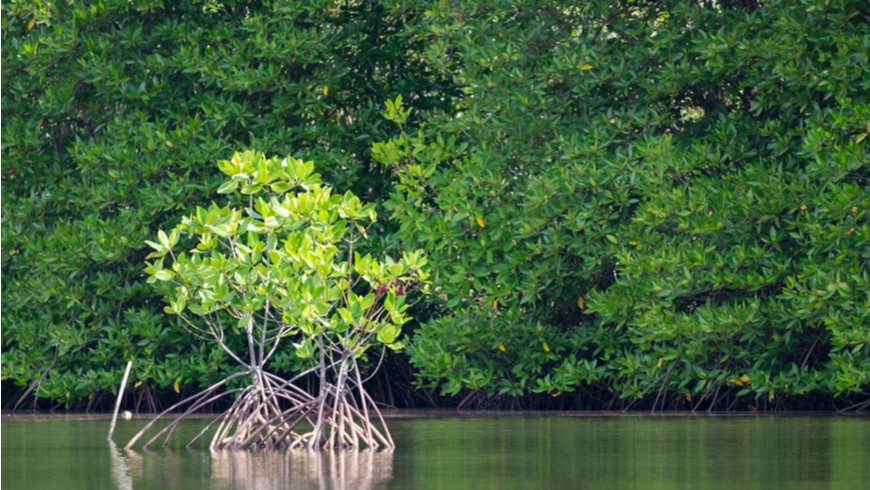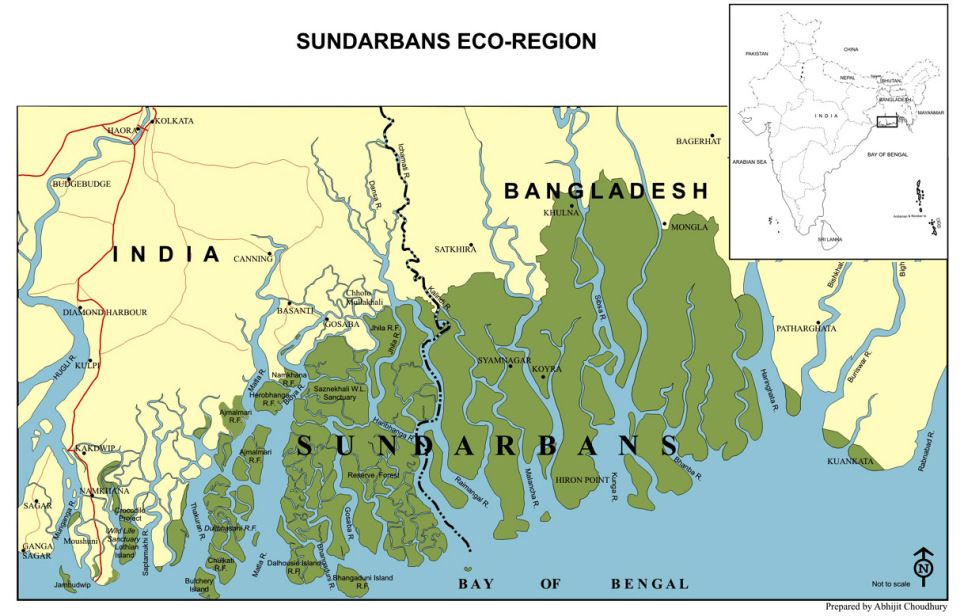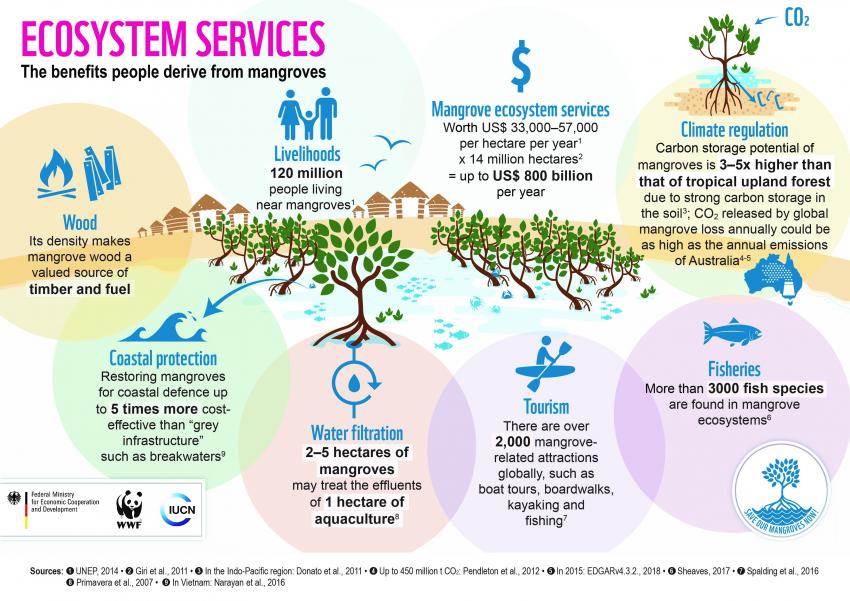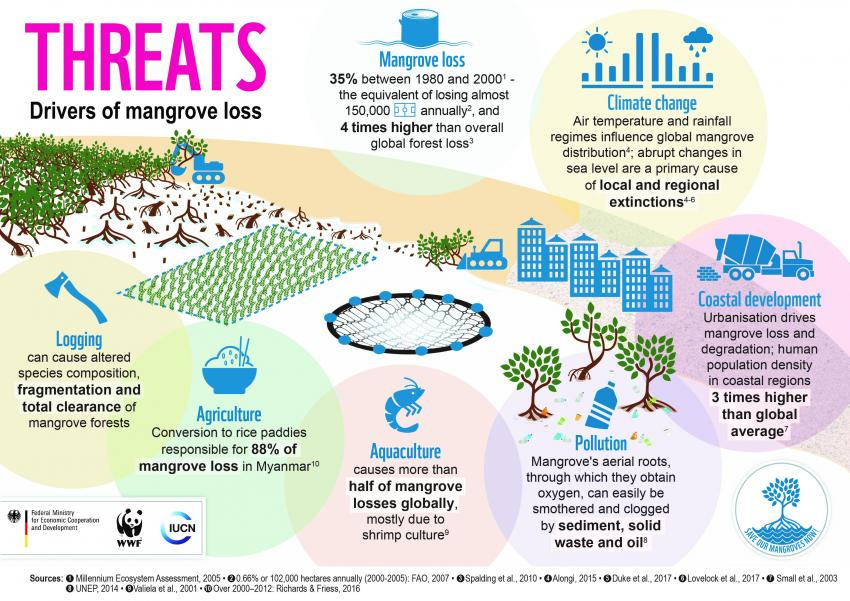Mangroves
2023 FEB 17
Mains >
Environment & Ecology > Biodiversity > Biogeography

IN NEWS:
- Budget 2023-24 announced the Mangrove Initiative for Shoreline Habitats and Tangible Incomes (MISHTI), where mangrove plantations will be taken up along the country’s coastline and salt pan lands.
- Union Finance Minister also announced a special scheme called 'Amrit Dharohar' for protecting vital wetlands which sustain aquatic biodiversity. Read more on wetland here.
WHAT ARE MANGROVES:
- Mangroves are salt tolerant plant communities found in tropical and sub-tropical intertidal regions of the world.
- Such areas are characterised by high rainfall (between 1000 mm to 3000 mm) and temperature (between 26-35 ?C). They occur worldwide in the tropics and subtropics, mainly between latitudes 25° N and 25° S.
- Mangroves are restricted mainly to the tropical areas as they cannot tolerate the extreme cold events typical of the temperate zone.

FEATURES OF MANGROVES:
Mangroves are adapted to surviving in waterlogged and anoxic soil, including slow-moving and brackish water due to some of its distinct features.
- Halophytes: Mangrove species survive by filtering out as much as 90% of the salt found in seawater as it enters their roots. Some species excrete salt through glands in their leaves.
- Water retention capacity: Mangroves store fresh water in thick succulent leaves. A waxy coating on the leaves of some mangrove species seals in water and minimizes evaporation.
- Pneumatophores: Some mangroves grow pencil-like roots that stick up out of the ground like snorkels and take in oxygen from the air. These roots allow mangroves to cope with daily flooding by the tides.
- Prop roots: Many mangrove trees have dense intertwined aerial roots that descend from their trunks and branches that stabilize and support them from battering waves and shifting tides.
- Lenticellated bark: Besides the root, oxygen enters a mangrove through lenticels, thousands of cell-sized breathing pores in the bark and roots. This helps them adapt to the low oxygen conditions.
- Viviparous: Seed pods germinate while on the tree, so they are ready to take root when they drop.
MANGROVES IN INDIA:
- According to the India state of forest report, 2021, the mangrove cover in India is 4,992 sq km, which is 0.15% of the country's total geographical area.
- Among the states and UTs, West Bengal has the highest percentage of area under total Mangrove cover followed by Gujarat and Andaman Nicobar Islands.
- Mangrove areas of the country include the Sunderbans Tiger Reserve, Bhitarkanika, Coringa, Nelapattu, Point Calimere Wildlife Sanctuaries, Pirotan National Park and other areas.

|
SUNDARBANS:
- The Sundarbans is the largest contiguous mangrove forest in the world. Its name derives from the dominant mangrove species sundari (Heritiera fomes).
- It spans from the Hooghly River in India's state of West Bengal to the Baleswar River in Bangladesh, covering the deltas of the Ganges, Brahmaputra and Meghna rivers.
- Four protected areas in the Sundarbans are enlisted as UNESCO World Heritage Sites, viz. Sundarbans National Park, Sundarbans West, Sundarbans South and Sundarbans East Wildlife Sanctuaries.
- The area is known for its wide range of fauna, including 260 bird species, the Bengal tiger and other threatened species such as the estuarine crocodile and the Indian python.

|
SIGNIFICANCE OF MANGROVES:

- Ecosystem services:
- Abode of biodiversity:
- Mangrove forests make up one of the most productive and biologically diverse ecosystems on the planet. They are home to an array of species, making them an important biodiversity hotspot.
- Nursery for species:
- Mangroves serve as valuable nursery areas for fish and invertebrates. These habitats provide a rich source of food while also offering refuge from predation.
- Biological barrier:
- The ability to retain sediments flowing from upstream prevents contamination of downstream waterways and protects sensitive habitat like coral reefs and seagrass beds below.
- Water filtration:
- With their dense network of roots and surrounding vegetation, mangroves filter and trap sediments, heavy metals, and other pollutants, thereby maintaining water quality.
- Economic significance:
- Fisheries:
- Mangrove forests are home to a large variety of fish, crab, shrimp, and mollusk species. This form an essential source of food and income for coastal communities around the world.
- Timber and plant products:
- Mangrove wood is resistant to rot and insects, making it for construction and fuel. Mangroves also provide minor forest products such as honey and resin.
- Tourism:
- Often located near to coral reefs and sandy beaches, the forests provide a rich environment for tourist activities like recreational tours, snorkelling and birdwatching.
- Shoreline stabilisation:
- The dense root systems of mangrove forests trap sediments flowing down rivers and off the land. This helps stabilizes the coastline and prevents erosion from waves and storms.
- Natural barrier:
- As risks from climate change brings about extreme weather events, mangrove forests can help lessen devastation in coastal areas.
- For instance, a mangrove forest could reduce the effects of a Category 5 storm to the intensity and effects of a Category 3 storm.
- Carbon sinks:
- Mangroves have the ability to absorb up to four times more carbon dioxide by area than upland terrestrial forests, making them among the planet's best carbon scrubbers. By protecting existing mangrove forests and allowing them to spread from their original habitats, we can mitigate the effects of climate change.
EXISTING PROTECTION MEASURES:
I. NATIONAL:
- Constitutional provisions:
- Article 48A of the Indian constitution puts an obligation on the part of the state to protect and improve the environment.
- National Committee on mangroves, wetlands and coral reefs:
- Constituted in 1993, it advises the Government on relevant policies and programmes regarding marine species.
- Centrally Sponsored Scheme (CSS) for Conservation and Management of Mangroves:
- It is operated by the Ministry of Environment, Forest & Climate Change.
- Under this programme, annual Management Action Plan (MAP) for conservation and management of mangroves are formulated and implemented in all the coastal States and Union Territories.
- 100% Central Assistance is provided to coastal States/Union Territories for implementation of their approved MAPs.
- Indian Forest Act, 1927:
- Several mangrove forests have been declared as reserved forests and protected forests based on the provision of the 1927 act.
- Marine Protected Areas (MPAs) under WPA:
- Some mangrove forests are protected under the Marine Protected Areas. The MPAs are notified under Wildlife (Protection) Act, 1972 (WPA) either as National Parks or as Wildlife Sanctuary.
- Forest Conservation Act, 1980:
- It provides effective protection to the forest resources. This act mandates prior approval from the Central Government for using forest land for the non-forest purpose.
- Environment (Protection) Act, 1986 (EPA):
- It gives indirect protection to the mangroves. It empowers the Central government to make various notifications and rules to regulate environmental pollution.
- Coastal Regulation Zone (CRZ) notification:
- It prohibits developmental activities and disposal of wastes in the fragile coastal ecosystems. It also protects the livelihoods of millions of people through the sustainable management.
- The Biological Diversity Act of India,2002
- BDA 2002, Biological Diversity Rules 2004, and the guidelines thereof advise the Government on matters related to the protection and conservation of biodiversity, sustainable use and equitable sharing of its components, Intellectual Property Rights, etc.
- State government efforts:
- There are several state laws and initiatives that extend protection to mangroves.
- For instance, Maharashtra Government has set up Mangrove and Marine Biodiversity Conservation Foundation for enhancing mangrove cover and to promote research and livelihood activities and a Mangrove Cell dedicated for Mangrove conservation.
- Magical Mangroves campaign:
- It is a nation-wide citizen campaign, by Godrej & Boyce Mfg Co Ltd (G&B), in collaboration with WWF India, which highlights the significance of mangrove conservation in present times.
- The campaign spans across nine states: Maharashtra, Goa, Gujarat, Andhra Pradesh, Tamil Nadu, Kerala, Odisha, West Bengal and Karnataka.
- The volunteers will be part of webinars, film screenings, online quizzes and digital story-telling sessions, among other activities.
II. INTERNATIONAL:
In the international level, there is neither any specific Convention, nor any other mechanism which deals with the protection of mangroves. However, from the existing international documents, an indirect obligation of the States to protect and preserve mangroves could be inferred.
- Ramsar Convention:
- Officially called the ‘The Convention on Wetlands of International Importance especially as Waterfowl Habitat’, Ramsar convention is an intergovernmental treaty that provides the framework for national action and international cooperation for the conservation and wise use of wetlands and their resources.
- Agenda 21 of Rio declaration:
- It says about the protection of the oceans, all kinds of seas, including enclosed and semi-enclosed seas, and coastal areas and the protection, rational use and development of their living resources.
- Red List of Ecosystems (RLE) Framework of IUCN:
- RLE is a global framework for monitoring and documenting the status of ecosystems.
- It was developed by the International Union for Conservation of Nature (IUCN) for biodiversity risk assessment.
- Its main objectives are to support conservation, resource use and management decisions by evaluating all the world's ecosystems by 2025.

THREATS TO MANGROVES:

- Change in land-use:
- Area of mangrove forest continue to shrink. For instance, shrimp aquaculture, and salt farms lead to clearing of mangroves, dredging, and diking.
- When mangroves are cleared, the strong waves and currents reach the coast and wash away the fine sediment in which the mangroves grow. This can also prevent seedlings from taking root and wash away nutrients essential for mangrove ecosystems.
- Irresponsible tourism:
- Unregulated tourism has taken its toll on the environmental integrity of the mangroves. Creation of walkways and tourist amenities and littering is changing the physical characteristics of mangrove forests.
- Pollution:
- Municipal wastes and agricultural runoff containing pesticides, antibiotics and other pollutants are making its way into water supplies.
- Another major threat is from thermal pollution and oil spills, as they smother mangrove roots and suffocate the trees.
- River diversion:
- Dams and irrigation reduce the amount of water reaching mangrove forests, changing the salinity level of water in the forest.
- For eg: the construction of Farakka Barrage in 1975 has altered fresh water flow around the delta, thereby altering the ecology of Sundarbans.
- Lumber industry:
- Chopping down mangroves for charcoal and timber is an important cottage industry. While harvesting has taken place for centuries, in some parts of the world it is no longer sustainable, threatening the future of the forests.
- Invasive species:
- Plantation of fast-growing non-native mangrove species has been used as a tool for mangrove restoration in several countries. However, the fast-growth ability has made some species invasive and gradually replacing co-occurring native mangroves.
- Climate change:
- Mangroves need freshwater to maintain the estuarine conditions they thrive in. But as sea-levels rise, the swamps become more saline, threatening some tree species go extinct.
- Natural threats:
- Powerful storms and hurricanes may also severely damage mangrove habitats. Winds, waves, and flooding may be destructive enough to clear entire mangrove islands.
- Shortcomings in legislations and enforcement:
- Forest law enforcement in India appears weak, and penalties devised by various legal instruments such as the Forest Act 1927 are ineffective. Also, since the CRZ is only a notification, it could not be enforced strictly.
WAY FORWARD:
- Scientific management:
- Scientific management practices are essential for conservation and sustainable management of mangrove forests. Governments need to take efforts for the restoration and rehabilitation of degraded mangrove areas, particularly in climate-vulnerable coastal areas.
- Socio-economic studies:
- The traditional rights of coastal communities should be recognized while formulating and implementing regulations and conservation measures. For this, socioeconomic studies on the mangrove-dependent people need to be taken up.
- Mapping and planning:
- Floristic survey of mangroves along the coast is to be taken up to prepare biodiversity atlas for mangroves. Based on this, potential areas are to be identified for implementing the management action plan for mangroves.
- Encourage people’s participation:
- The participation of the local community should be made compulsory for conservation and management. People’s involvement in mangrove management on public and private lands can greatly aid conservation efforts.
- Encourage private players:
- Coastal industries and private owners need to be persuaded to actively participate in protecting and developing mangrove biodiversity. Also, incentives for sustainable management of mangroves on private and village community land may be encouraged.
- Promote awareness:
- Programmes to raise people’s awareness of the importance of mangroves through measures such as exhibitions, seminars, nature camps, and establishment of mangrove parks.
- Ensure minimum flow:
- Hydel projects are under an obligation to release minimum water downstream. However, states should ensure that these norms are followed.
- Research support:
- Research and international collaboration on problems related to appropriate management of the mangrove ecosystem is vital for the development of scientific conservation plans.
- Alternative livelihood:
- Alternative sources of income generation like dairy farming, bee keeping, ecotourism and agro-forestry should be encouraged in mangrove-dependent communities.
PRACTICE QUESTION:
Q. Discuss the causes of depletion of mangroves and explain their importance in maintaining coastal ecology. (GS 1, UPSC CSE 2019)





